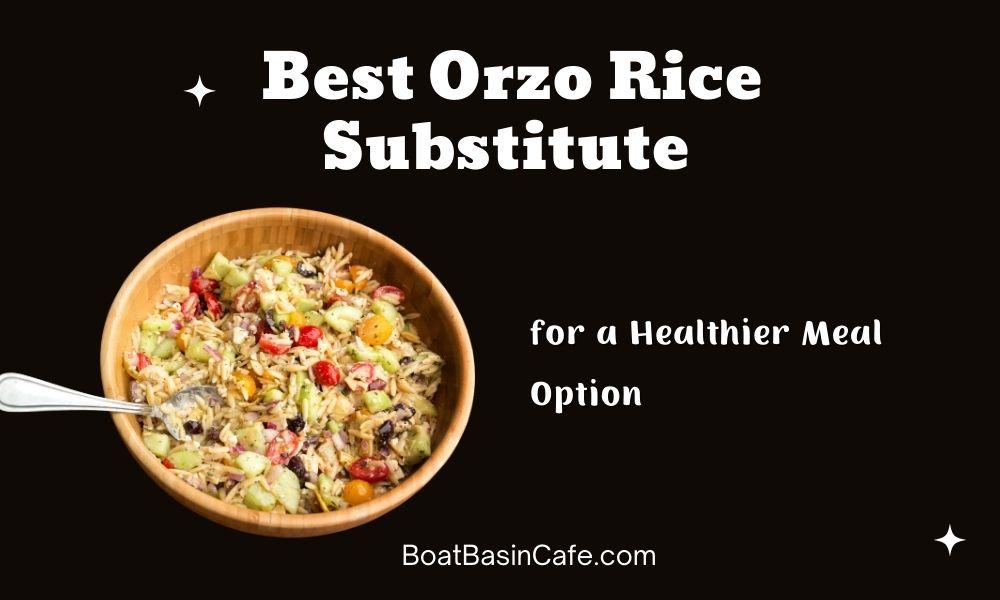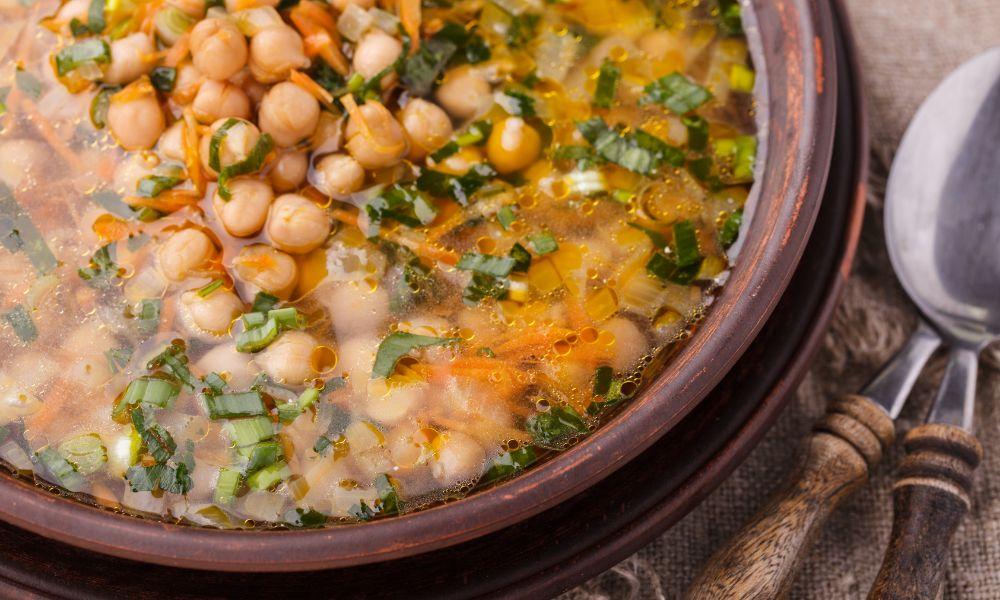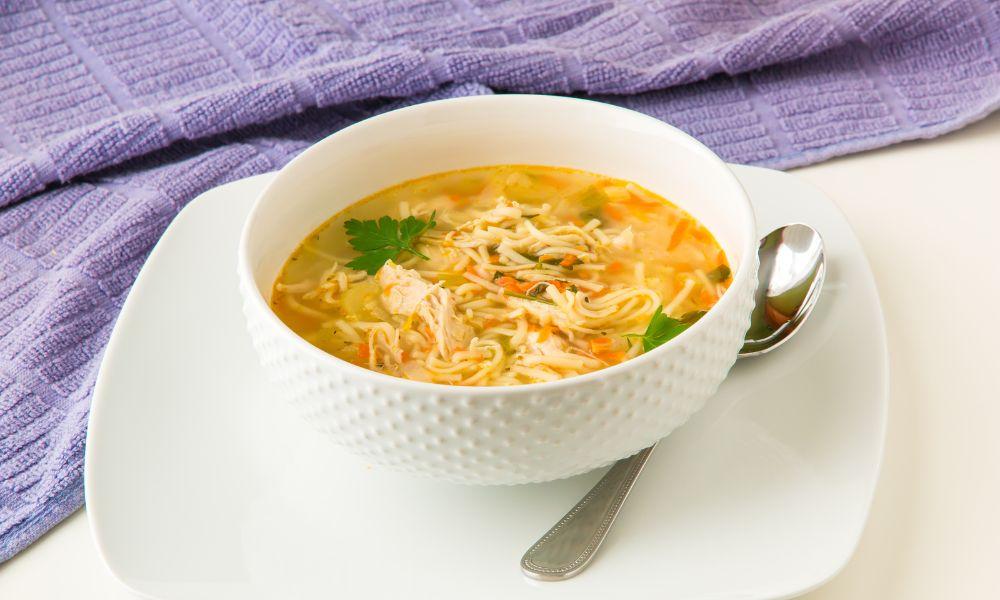Are you tired of eating the same old rice or pasta dishes? Do you want to try something new and healthier? If yes, then you’ve come to the right place. In this article, we’ll explore the best Orzo Rice Substitute options that are perfect for a healthy meal.

A Brief Overview of Orzo
Orzo is a small, rice-shaped pasta made from wheat flour. It is popular in Mediterranean and Middle Eastern cuisines and is used in various dishes, including salads, soups, and casseroles. Orzo is known for its slightly nutty flavor and chewy texture, which sets it apart from rice.
Rice vs. Orzo
| Aspect | Rice | Orzo |
|---|---|---|
| Composition | Grain, made from the seeds of grass species | Pasta, made from wheat flour |
| Texture | Softer when cooked | Chewier and slightly denser when cooked |
| Flavor | Mild, slightly nutty | More pronounced nutty flavor |
| Cooking Time | Varies depending on rice type, generally longer | Cooks faster than rice |
| Gluten Content | Gluten-free | Contains gluten |
| Protein Content | Lower in protein (white rice) | Higher in protein |
| Fiber Content | Lower in fiber (white rice) | Higher in fiber |
| Nutrient Profile | Varies; whole grain varieties retain more nutrients | Good source of B vitamins, iron, and minerals |
| Dietary Suitability | Suitable for gluten-free diets | Not suitable for gluten-free diets |
Health Benefits of Using Orzo Rice

Higher protein content
Orzo contains more protein than white rice, making it a better option for individuals looking to increase their protein intake.
Increased fiber
Orzo is higher in fiber compared to white rice, which can aid in digestion and help maintain healthy blood sugar levels.
Rich in nutrients
Orzo is a good source of B vitamins, iron, and other essential minerals. In comparison, white rice loses many of these nutrients during processing, although whole grain rice varieties, like brown rice, retain more nutrients.
Versatility
Orzo’s unique texture and flavor can add variety to your meals, allowing you to experiment with different dishes while still enjoying the familiar appearance of rice.
Types of Orzo
Plain Orzo
The most common type of orzo, plain orzo is made from refined wheat flour. It has a slightly nutty flavor and a chewy texture. This type of orzo is suitable for a wide range of dishes, including salads, soups, and casseroles.
Whole Wheat Orzo
Made from whole wheat flour, whole wheat orzo is a more nutritious alternative to plain orzo. It retains the bran and germ of the wheat, resulting in a higher fiber and nutrient content. Whole wheat orzo has a slightly denser texture and a more robust, earthy flavor compared to plain orzo.
Gluten-Free Orzo
For individuals with gluten sensitivity or celiac disease, gluten-free orzo is available as an alternative. Gluten-free orzo is typically made from alternative grains or flours, such as rice, corn, or quinoa. The texture and flavor may vary depending on the ingredients used, but gluten-free orzo can be a suitable substitute in various dishes that call for traditional orzo.
Cooking with Orzo

Orzo is a versatile and easy-to-cook pasta that can be used in a variety of dishes. Here’s an overview of how to prepare orzo, different cooking methods, and tips for achieving perfectly cooked orzo.
Preparing Orzo
Before cooking orzo, measure out the desired amount according to your recipe or the number of servings you need. In most cases, you do not need to rinse orzo before cooking, as it is a type of pasta. However, if you prefer to rinse it, doing so can help remove some of the excess starch.
Cooking Methods
There are several ways to cook orzo, depending on your desired outcome and the dish you are preparing. Here are three common methods:
Boiling: The most common method for cooking orzo is boiling. Bring a pot of salted water to a rolling boil, add the orzo, and cook for 8-10 minutes or until al dente. Be sure to stir occasionally to prevent the orzo from sticking together or to the bottom of the pot. Once cooked, drain the orzo in a colander and serve immediately, or use it in your desired dish.
Toasting: Toasting orzo before boiling adds a depth of flavor and a slightly nuttier taste. To toast orzo, heat a small amount of oil or butter in a skillet over medium heat. Add the orzo and cook, stirring frequently, until the orzo is golden brown. Once toasted, remove from heat and proceed with boiling the orzo as described above.
Baking: Orzo can also be used in baked dishes, such as casseroles or baked pasta dishes. In this case, you may need to partially cook the orzo by boiling it for a shorter time (about 5-6 minutes) before combining it with the other ingredients and baking it in the oven.
Tips for Perfectly Cooked Orzo
- Salt the water: Adding salt to the boiling water helps to season the orzo and enhance its flavor.
- Stir occasionally: Stirring the orzo while it cooks can help prevent it from sticking together or to the bottom of the pot.
- Test for doneness: To ensure perfectly cooked orzo, taste a piece of pasta a minute or two before the recommended cooking time. The orzo should be cooked al dente, which means it is tender but still has a slight bite to it.
- Drain well: Once the orzo is cooked, drain it in a colander and shake off any excess water. If desired, you can toss the orzo with a small amount of oil or butter to prevent it from sticking together as it cools.
- Time your cooking: If using orzo in a dish that requires additional cooking, like a casserole or stir-fry, slightly undercook the orzo before combining it with the other ingredients. This will help prevent overcooked, mushy orzo in the final dish.
Orzo in Different Cuisines
Orzo’s versatility makes it an excellent ingredient in various cuisines, allowing you to create dishes with a range of flavors and cultural influences. Here are some ways to incorporate orzo into Mediterranean, Asian-inspired, and Latin American and Caribbean dishes:
Mediterranean Dishes
Orzo is a staple in Mediterranean cuisine and is often used in salads, soups, and side dishes. Some examples include:
Greek Orzo Salad

Toss cooked orzo with diced tomatoes, cucumbers, red onions, Kalamata olives, and crumbled feta cheese. Dress the salad with olive oil, lemon juice, and a mix of Greek herbs and spices like oregano and thyme.
Orzo and Chickpea Soup

Create a hearty soup by combining cooked orzo with chickpeas, vegetables like carrots and celery, and a tomato-based broth. Season with garlic, bay leaves, and fresh herbs like parsley or basil.
Orzo Risotto

Cook orzo risotto-style by slowly adding vegetable or chicken broth and stirring frequently. Add sautéed mushrooms, peas, or other vegetables, and finish with grated Parmesan cheese and a drizzle of olive oil.
Asian-Inspired Recipes
Orzo can be used to create Asian-inspired dishes by incorporating flavors and ingredients typically found in Asian cuisine. Some examples include:
Orzo Fried Rice

Replace rice with cooked orzo in a classic fried rice recipe. Sauté vegetables, like carrots, peas, and onions, in sesame oil, add the orzo and scrambled eggs, and season with soy sauce and a touch of ginger.
Orzo Noodle Soup

Use orzo in place of noodles in an Asian-inspired soup. Combine cooked orzo with a miso or chicken broth, and add thinly sliced vegetables, such as mushrooms, bok choy, or scallions. Top with tofu, shredded chicken, or cooked shrimp for added protein.
Asian Orzo Salad

Mix cooked orzo with thinly sliced cabbage, bell peppers, carrots, and edamame. Toss the salad with a dressing made from rice vinegar, soy sauce, sesame oil, and a touch of honey. Garnish with sesame seeds and chopped cilantro or green onions.
Latin American and Caribbean Flavors
Incorporate orzo into Latin American and Caribbean-inspired dishes by using regional flavors and ingredients:
Orzo Arroz con Pollo

Prepare a Latin American-style chicken and rice dish using orzo instead of rice. Cook chicken pieces with onions, garlic, and bell peppers, then add orzo, chicken broth, and seasonings like cumin, paprika, and saffron. Simmer until the orzo is cooked and the flavors meld together.
Caribbean Orzo and Black Bean Salad

Combine cooked orzo with black beans, diced mango, avocado, and red onion. Create a dressing with lime juice, olive oil, and a mix of Caribbean spices like allspice, cayenne pepper, and thyme. Toss the salad and garnish with fresh cilantro.
Orzo with Sofrito
Cook orzo with a flavorful sofrito base made from sautéed onions, garlic, bell peppers, and tomatoes. Season the dish with Latin American spices like cumin, oregano, and achiote (annatto) powder. Add vegetables like peas, corn, or olives, and serve as a side dish or with a protein like grilled chicken or shrimp.
Reasons to Consider an Orzo Substitute
There are several reasons why you might want to consider using an orzo substitute in your recipes. Some of these reasons include:
Dietary Restrictions
Individuals with gluten sensitivity or celiac disease must avoid gluten-containing grains like wheat, which is the primary ingredient in orzo. In such cases, a gluten-free substitute is necessary.
Nutritional Concerns
Some people may prefer a more nutritious option than traditional orzo, which is made from refined wheat flour. Opting for whole-grain or higher-protein alternatives can help to increase the nutritional value of a dish.
Low-Carb Diets
Those following a low-carb diet, such as the ketogenic diet, need to reduce their intake of high-carb foods like pasta, including orzo. In these instances, a low-carb substitute like cauliflower rice or shirataki rice can be a suitable alternative.
Allergies
Although rare, some individuals may have allergies or sensitivities to wheat or other ingredients in orzo. In such cases, it is essential to find a suitable substitute that does not trigger allergic reactions.
Texture and Flavor Preferences
Different people have different preferences when it comes to the texture and flavor of their food. Some may prefer a chewier or softer texture, while others might want a milder or more pronounced flavor. Experimenting with orzo substitutes can help you discover new favorites that better suit your personal preferences.
Culinary Creativity
Trying new ingredients and experimenting with different substitutes can lead to unique and delicious dishes. Substituting orzo with alternative grains or pasta shapes can offer a fresh take on traditional recipes and inspire culinary creativity.
Top 5 Orzo Rice Substitutes
If you’re looking for an alternative to orzo, whether for dietary reasons or to try something new, here are the top 5 orzo rice substitutes:
Risoni
Also known as “rice-shaped pasta,” risoni is nearly identical to orzo in size, shape, and texture. It is made from wheat flour and can be used interchangeably with orzo in most recipes.
💡Cooking Tips: Since risoni is similar to orzo in size, shape, and texture, you can cook it using the same methods you would use for orzo. Boil risoni in salted water until al dente, then drain and incorporate it into your recipes.
👩🍳 Liquid Ratios: Cook risoni using the same liquid ratio as orzo, which is typically a 1:3 ratio of pasta to water or broth.
Israeli Couscous (Ptitim)
Israeli couscous, or ptitim, is a small, round, pearl-like pasta made from wheat flour. Although slightly larger than orzo, it offers a similar texture and can be used in a variety of dishes, including salads, soups, and side dishes.
💡Cooking Tips: To cook Israeli couscous, first toast it in a small amount of oil until it turns golden brown. Then, add water or broth and simmer until tender. The toasting step adds depth to the flavor and ensures that the couscous doesn’t become mushy.
👩🍳 Liquid Ratios: Cook risoni using the same liquid ratio as orzo, which is typically a 1:3 ratio of pasta to water or broth.
Quinoa
Quinoa is a gluten-free, high-protein seed that has a slightly nutty flavor and a fluffy texture when cooked. While not identical in shape to orzo, quinoa can be used in many dishes as a nutritious alternative. It works well in salads, side dishes, and even as a base for a pilaf or risotto-style dish.
💡Cooking Tips: Rinse quinoa thoroughly under cold water to remove any residual saponins that could impart a bitter taste. Then, cook quinoa in a 1:2 ratio of quinoa to water or broth, bringing it to a boil, reducing the heat, and simmering it for 12-15 minutes until the liquid is absorbed.
👩🍳 Liquid Ratios: Use a 1:2 ratio of quinoa to water or broth is recommended for achieving a fluffy, tender texture.
Barley
Barley is a versatile and nutritious whole grain with a chewy texture and a mild, slightly nutty flavor. Although larger than orzo, it can be used as a substitute in soups, salads, and side dishes, adding extra fiber and nutrients to your meal.
💡Cooking Tips: For pearled barley, use a 1:3 ratio of barley to water or broth. Bring the liquid to a boil, then reduce the heat and let it simmer for 25-30 minutes until the barley is tender but still chewy. For hulled barley, you may need to increase the cooking time to 40-50 minutes.
👩🍳 Liquid Ratios: For pearled barley, use a 1:3 ratio of barley to water or broth. For hulled barley, you may need to slightly increase the amount of liquid.
Cauliflower Rice
For those seeking a low-carb alternative, cauliflower rice is an excellent option. Pulse raw cauliflower florets in a food processor until they reach a rice-like consistency, then sauté or steam to create a versatile base for various dishes. Cauliflower rice can be used in place of orzo in salads, stir-fries, and other recipes that call for a rice-like texture.
💡Cooking Tips: To make cauliflower rice, pulse raw cauliflower florets in a food processor until they reach a rice-like consistency. To cook, sauté the cauliflower rice in a pan with a small amount of oil over medium heat for 5-8 minutes until it’s tender but not mushy. Alternatively, you can steam cauliflower rice for a few minutes until it reaches the desired texture.
💡Cooking Tips: Since cauliflower rice doesn’t absorb liquid the way grains and pasta do, there is no specific liquid ratio required. Simply sauté or steam the cauliflower rice until it reaches the desired texture.
Conclusion
In conclusion, orzo rice substitutes offer a diverse range of options for those looking to experiment with new ingredients, accommodate dietary restrictions, or simply add variety to their meals. Each substitute brings its unique characteristics, textures, and flavors to the table, making it essential to consider their specific cooking times and liquid ratios to achieve the best results.
By exploring these alternatives and applying the appropriate cooking techniques, you can create delicious, satisfying dishes that cater to different tastes and dietary needs, all while enjoying the versatility and convenience of orzo-like grains, seeds, and pasta.
FAQs
Is orzo healthier than rice?
While orzo and rice have their own unique nutritional profiles, orzo is generally higher in protein and fiber compared to white rice. However, whole grain rice varieties, such as brown rice, may offer more nutritional benefits.
Can I use orzo in a rice cooker?
Although it is possible to cook orzo in a rice cooker, it is essential to monitor the cooking process closely, as orzo typically cooks faster than rice.
Is orzo suitable for a gluten-free diet?
No, orzo is not suitable for a gluten-free diet as it is made from wheat flour. Gluten-free alternatives include quinoa, rice, and gluten-free pasta.
Can I use orzo as a substitute for Arborio rice in risotto?
Yes, orzo can be used as a substitute for Arborio rice in risotto. However, the texture and flavor may differ slightly from traditional risotto.
Do I need to rinse orzo before cooking?
Rinsing orzo before cooking is not necessary, as it is a type of pasta. However, if you prefer to rinse it, doing so can remove some of the excess starch.